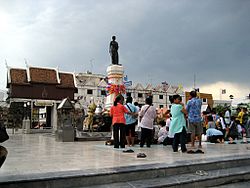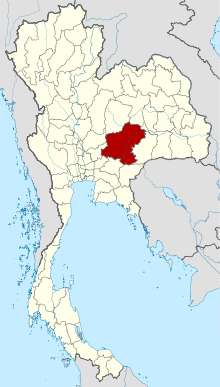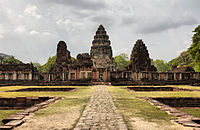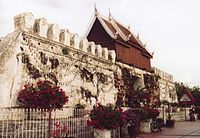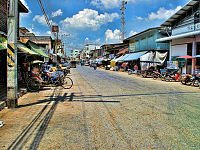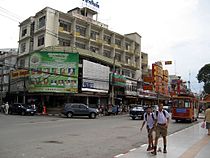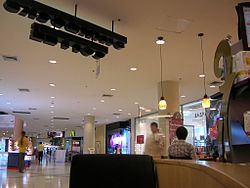- Nakhon Ratchasima Province
-
Nakhon Ratchasima
นครราชสีมา— Province — Statue of Lady Mo in Khorat city centre 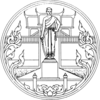
SealNickname(s): Korat, Khorat Map of Thailand highlighting Nakhon Ratchasima Province Country  Thailand
ThailandCapital Nakhon Ratchasima Government – Governor Rapee Phongbupakit (since October 2010) Area – Total 20,494.0 km2 (7,912.8 sq mi) Area rank Ranked 1st Population (December 31, 2010) – Total 2,582,089 – Rank Ranked 2nd – Density 126/km2 (326.3/sq mi) – Density rank Ranked 34th Time zone Thailand Standard Time (UTC+7) ISO 3166 code TH-30 Website www.nakhonratchasima.go.th Nakhon Ratchasima (Thai: นครราชสีมา) or (Khmer: Nokor Reach Seyma), often shortened to Korat or Khorat (โคราช), is one of the north-eastern provinces (changwat) of Thailand. Neighboring provinces are (clockwise, from north) Chaiyaphum, Khon Kaen, Buriram, Sa Kaeo, Prachinburi, Nakhon Nayok, Saraburi, Lopburi.
The capital of the province is The City of Nakhon Ratchasima located in Mueang Nakhon Ratchasima District, also called Korat or Khorat.
Contents
Geography
The province is located on the western end of the Khorat Plateau, separated from the Chao Phraya river valley by the Phetchabun and Dong Phaya Yen mountain ranges. Two national parks are in the province - the Khao Yai in the west and the Thab Lan in the south. Both parks are in the forested mountains of the Sankambeng Range, the southern prolongation of the Dong Phaya Yen mountains
Nakhon Ratchasima, or "Khorat," is a large province on the northeastern plateau and acts as a gateway to other provinces in the Northeast. It is 259 kilometres from Bangkok and has an area of around 20,494 square kilometres, making it the biggest province in Thailand. The province is rich in Khmer culture and has a long history.
History
The area around Korat was already an important center in the times of the Khmer empire in the 11th century, as can be seen by the temple ruins in the Phimai historical park. Still, Nakhon Ratchasima Province is one of the provinces where there is a sizable Northern Khmer population.[1]
A new walled-city with a surrounding moat, designated as Nakhon Ratchasima, was built in the seventeenth century by order of the King Narai, as the easternmost 'command post', guarding the Kingdom's border and supervising its Lao and Cambodian 'vassals'. It continued this duty during the Bangkok Period, although it was seized by deceit during Chao Anuwong of Vientiane's 1826 revolt against the King Rama III of Siam.
Nakhon Ratchasima has long been the most important political and economic center in the northeastern region. In the late nineteenth century, the railroad reached Korat became the junction of two main rail lines in the Northeastern, Isan, region.
In 1933 it was the stronghold of the royalist troops in the Boworadej Revolt, against the new ostensibly democratic government in Bangkok.
In the 1970s, the province was the site of United States military bases supporting the Vietnam War.
Symbols
Provincial seal
A monument of Thao Suranaree or Khun Ying MO (1771–1852) situated in front of the old gate of "Prau Chumpon". The Great Heroine of Korat ; Thao Suranaree, wife of the Deputy Governor of Korat during the reign of King Rama III. In 1826s Khun Ying Mo, managed to save the city from the invasion of the Laotian army led by Prince Anouvong of Vientiane. King Rama III conferred the title of Thao Suranaree on Khun Ying Mo, as well as conferring additional titles honouring her bravery.
Provincial Tree
Sa-Thorn (Millettia leucantha Kurz)
Provincial Motto-
- Land of brave women, Fine Silk material, Khorat Rice noodle, Phimai historical park, and Dan Kwian Ceramics.
Administrative divisions

The province is subdivided into 32 districts (amphoe). The districts are further subdivided into 263 subdistricts (tambon) and 3743 villages (muban).
- Mueang Nakhon Ratchasima
- Khon Buri
- Soeng Sang
- Khong
- Ban Lueam
- Chakkarat
- Chok Chai
- Dan Khun Thot
- Non Thai
- Non Sung
- Kham Sakaesaeng
- Bua Yai
- Prathai
- Pak Thong Chai
- Phimai
- Huai Thalaeng
- Chum Phuang
- Sung Noen
- Kham Thale So
- Sikhio
- Pak Chong
- Nong Bun Mak
- Kaeng Sanam Nang
- Non Daeng
- Wang Nam Khiao
- Thepharak
- Mueang Yang
- Phra Thong Kham
- Lam Thamenchai
- Bua Lai
- Sida
- Chaloem Phra Kiat
- As of May 15, 2007, the Government has upgraded all those 81 King Amphoe to Amphoe in order to facilitate the administration.
Districts General Information class Name Area
(km2.)Distance to
Provincial Hall
(km.)Establish Subdistrict
(Unit)Village
(Unit)Population. Male Female Total Special Mueang Nakhon Ratchasima755.596 0 1895 25 243 212,627 221,211 433,838 1 Dan Khun Thot1,428.14 84 1908 16 220 62,571 63,347 125,918 1 Bua Yai305.028 101 1886 10 121 41,855 42,278 84,133 1 Pak Thong Chai1,374.32 34 1910 16 213 56,716 58,950 115,666 1 Phimai896.871 60 1900 12 208 64,421 66,024 130,445 1 Sikhio1,247.07 45 1955 12 169 60,898 61,163 122,061 1 Pak Chong1,825.17 85 1955 12 217 91,146 91,685 182,831 2 Khon Buri1,816.85 58 1939 12 152 46,086 47,167 93,253 2 Chakkarat501.672 40 1953 8 108 34,441 34,643 69,084 2 Chok Chai503.917 30 1905 10 126 37,297 39,223 76,520 2 Non Sung676.981 37 1897 16 195 62,639 65,374 128,013 2 Prathai600.648 97 1961 13 148 38,622 38,761 77,282 2 Sung Noen782.853 36 1901 11 125 38,429 40,181 78,610 2 Huai Thalaeng495.175 65 1961 10 120 37,443 37,131 74,574 2 Chum Phuang540.567 98 1959 9 130 40,918 41,038 82,161 3 Soeng Sang1,200.24 88 1976 6 84 33,733 33,302 67,032 3 Khong454.737 79 1938 10 155 40,052 41,076 81,128 3 Non Thai541.994 28 1900 10 131 36,126 37,592 73,718 3 Kham Sakaesaeng297.769 50 1968 7 72 21,423 21,753 43,176 3 Kaeng Sanam Nang107.258 130 1986 5 56 18,782 19,054 37,836 3 Wang Nam Khiao1,130.00 70 1992 5 83 20,416 20,503 40,910 4 Ban Lueam218.875 85 1976 4 39 10,620 10,732 21,351 4 Nong Bunmak590.448 52 1983 9 104 29,424 29,316 58,740 4 Thepharak357.465 90 1995 4 58 12,002 11,451 23,453 4 Phra Thong Kham359.522 45 1996 5 74 21,260 21,680 42,940 4 Sida162.825 85 1997 5 50 12,087 12,133 24,220 4 Bua Lai106.893 103 1997 4 45 12,374 12,450 24,824 4 Non Daeng193.407 30 1989 5 65 12,597 12,984 25,581 4 Kham Thale So203.605 22 1966 5 46 14,091 14,021 28,112 4 Mueang Yang255.522 110 1995 4 44 14,321 14,038 28,359 4 Lam Thamenchai308.457 120 1996 4 59 16,114 15,953 32,067 4 Chaloem Phra Kiat254.093 18 1996 5 61 16,966 17,411 34,377 Transportation
Roads Highway 2 (Mittraphap Road) is the main route that connects 9 districts in Nakhon Ratchasima including Muang district. This route also connects Nakhon Ratchasima to Saraburi and Khon Kaen provinces. As, Highway No. 24 links Si Khio district from the Highway 2 to Pak Thongcha, Chok Chai and Nong Bunnak districts and to Burirum province.
Rail systems The railway system in Nakhon Ratchasima is on both north-eastern routes from Bangkok’s Hua Lampong central terminal. Nakhon Ratchasima has 8 main railway stations.
Bus service Mini-bus and bus routes operate in the city and nearby areas. There are non air-conditioned buses from the provincial town which go to every district. As for travel to nearby provinces, there are both air and non air-conditioned ones.
Songthaew (public passenger pick-up vehicle) Songthaew or public passenger pick-up vehicle is the most popular mode of public transportation in all the town districts. These run on fixed routes.
Taxi Taxis are plentiful, clean, safe, and inexpensive in Korat. They can be found at taxi stands in the city areas or hailed on the streets. There are also certain taxis that can be requested by phone, however, the fare is slightly higher than regular taxis. An increasing number of taxi drivers nowadays speak some English which may prove extremely useful for first-time visitors. The fare system is based on both distance and time. Fares begin at 30 Bath for the first 2 kilometers.
Motorbike-taxi The motorbike taxis are found mainly in the town areas and are used mainly for short distances.Airport Nakhon Ratchasima has one airport but as of June 2007, it no longer services any flights. The nearest airport is in Buriram and has flights to and from Bangkok.
Tourism
Nakhon Ratchasima or Khorat, is Thailand’s largest province and the ‘Gateway to Isaan’ (Gateway to the North-East). It also has beautiful National Parks, with many forests, mountains, waterfalls, and reservoirs. Furthermore, it is well known for a variety of quality handicrafts that visitors can choose from. Regarding tourism, locals Thais make up the majority. Most foreigners who visit the north-east view Khorat as just a stepping stone and pass right through without taking the opportunity to tour this province with its interesting and diverse history, architecture and natural beauty.
Attractions
- Thao Suranari Monument (อนุสาวรีย์ท้าวสุรนารี) is a memorial to the Thai heroine called ‘Ya Mo’ by locals. Built in 1934, it is located in the city centre. Thao Suranari was originally Khun Ying Mo, the wife of the assistant governor of Nakhon Ratchasima. In 1826, Chao Anuwong of Vientiane invaded Siam and sacked Korat. After his forces rounded up families in Korat and began herding them back toward Vientien, Khun Ying Mo according to legend rallied villagers to fight against their captivity, enticing the Lao soldiers with rice wine and sex. They first confused and then overcome their captors in actions that introduced the first blunt against the Lao incursion into Siam. In honor of this King Rama III promoted Lady Mo to 'Thao Suranari'. Every year during 23 March to 3 April, people who respect Thao Suranari hold a festival to honor her bravery. There is, however, a great deal of disagreement, including between official government historians in Bangkok and local tellers, as to whether Lady Mo (or Miss Boonleu) even existed. Translation of a book that details accounts of Lady Mo, the events at Tung Samrit and important historical references to Chao Anuwong is currently under draft, as of 2 June 2009, by Frank G Anderson. The translation also contains the first-ever English language detailed description of the Thao Suranari statue, as well as references to the Italian sculptor who first created the model for casting, Corrado Feroci.
- Northeastern Museum of Petrified Wood and Mineral Resources (พิพิธภัณฑ์ไม้กลายเป็นหิน และทรัพยากรธรณีภาคตะวันออกเฉียงเหนือ ), at present, this area has a collection of over 10,000 petrified wood pieces. Some are displayed in the garden. Within this compound, petrified wood was unearthed just beneath the surface to 8 metres underground. The wood discovered is of various sizes from pebbles to rocks are aged from 1 to 70 million years old.
- Khao Yai National Park (อุทยานแห่งชาติเขาใหญ่) is the Phanom Dong Rak mountain range. It covers 4 provinces; Nakhon Ratchasima, Nakhon Nayok, Saraburi, and Prachin Buri. The jungle here divides the Central Region and the Northeast. Khao Yai became Thailand’s first national park on 18 September 1962 and is an ASEAN World Heritage because of its variety of flora and fauna. The general terrain of Khao Yai National Park consists of mixed forests and rainforests.
- Mueang Sema Historical Site (โบราณสถานเมืองเสมา) The Sema city plan is egg-shaped and is 3 kilometres wide and 4 kilometres long. The city flourished during the Dvaravati period and was built around the 12th Buddhist century. It grew until the 16th-17th Buddhist centuries when it came under Khmer influence. In the area are ruins made of laterite and sandstone and many artefacts have been unearthed here. The most interesting one is the reclining sandstone Buddha image and an old religious relic that is now in Wat Thammachak Semaram.
- Wat Thammachak Semaram (วัดธรรมจักรเสมาราม) The place used to be a religious site in the Dvaravati period. The important artefact here is a huge reclining Buddha image made of red sandstone that stretches from north to south. It is 13.30 metres long and 2.80 metres high. It dates from 657 AD. There is an old sandstone Buddhist symbol in the form of a cartwheel. Other artefacts include bronze Buddha images, fired clay images, glass beads, a fired clay loom, and a stone inscription tablet. They are on display in Phimai National Museum.
- An Ancient Town in Tambon Khorat or Ancient Khorat (เมืองโบราณที่ตำบลโคราชเก่า หรือ เมืองโคราช) is considered as the beginning point of the ancient Khmer civilization in Nakhon Ratchasima. There are overall 3 remaining ancient sites; namely, Prasat Non Ku, Prasat Mueang Khaek, and Prasat Mueang Kao.
- Prasat Non Ku (ปราสาทโนนกู่) In 1991–1992, a lot of archaeological evidence was excavated, creating an assumption that this place might possibly be a Hindu shrine.
- Prasat Mueang Khaek (ปราสาทเมืองแขก) It comprises a main sanctuary, 2 structures of Bannalai (library), gallery, entrance archways, pond, boundary wall, and a small brick building.
- Prasat Mueang Kao (ปราสาทเมืองเก่า) It can be noticed that the entrance of the temple was constructed similar to the city gate of old Khorat Town and there is a replica Monument of Thao Suranari (Khunying Mo or Ya Mo).
- Dan Kwian Pottery Village (หมู่บ้านทำเครื่องปั้นดินเผาด่านเกวียน) The area used to be a rest area for caravans trading between Khorat and Cambodia. The Mun River flows through it. Villagers use clay from the river banks to make pottery and have continued doing so for many generations. Nowadays Dan Kwian is famous as a crafts center most noted for the production beautiful ceramics in a great variety of designs.
- Ban Prasat Home Stay (โฮมสเตย์บ้านปราสาท) was formally introduced in 1996 and now Ban Prasat is the prototype of home stay programs in other villages around the country. Ban Prasat villagers are like other villagers in the region in that most are farmers. Rice farming is done once a year. Villagers use their free time to create handicrafts to supplement their income. Crafts include weaving reed mats and hats, using some trees to make shoes and bags, breeding silkworm, and making Thai stringed musical instruments like So U and So Duang.
- Phimai National Museum (พิพิธภัณฑสถานแห่งชาติ พิมาย) The museum collects archaeological artefacts and has exhibits on the past cultural prosperity of the Northeast, especially artefacts found in the lower part of the region. The exhibition is allocated to three different sections, which displays Isan culture and civilization affected from different periods from pre historic period till the present day.
- Phimai Historical Park (อุทยานประวัติศาสตร์พิมาย) in Phimai District, has one of the grandest and most important Khmer historical sites in Thailand that is the Phimai sanctuary. The word Phimai appears in an inscription on a stone slab at the front doorway of the building as well as in many other structures. It is believed that the word Phimai meant a religious figure or site. It consists of structures made of sandstone and laterite, all ornately carved with designs.
- Farm Chokchai (ฟาร์มโชคชัย) is one of the largest dairy farms in Asia. The farm offers agro-tourism activities with the guide showing the facilities, including the production of raw milk, raising milk cows, milking cows, horse-riding, touring horse stables, dog farms, and a zoo.
- Nakhon Ratchasima Zoo (สวนสัตว์นครราชสีมา) The zoo is one of the most modern in Asia. Most of the animals here are from Africa. Of note are penguins, seals, African elephants, rhinoceros, cheetahs, lions, zebras, and giraffes. . The zoo is ideal for biology study and relaxation. Beside, inside the Nakhon Ratchasima Zoo, there sections called the Children Zoo. The purpose of setting these sections is to provide children, youth or people the chance to have a close study about animals’ predicament and the new Water park Korat is in around the northeast.
Climate
Climate data for Nakhon Ratchasima (1961-1990) Month Jan Feb Mar Apr May Jun Jul Aug Sep Oct Nov Dec Year Average high °C (°F) 30.6
(87.1)33.5
(92.3)35.8
(96.4)36.5
(97.7)34.9
(94.8)34.1
(93.4)33.6
(92.5)33.1
(91.6)32.1
(89.8)30.9
(87.6)29.7
(85.5)29.3
(84.7)32.84
(91.12)Average low °C (°F) 16.8
(62.2)20.0
(68.0)22.2
(72.0)24.0
(75.2)24.5
(76.1)24.3
(75.7)23.9
(75.0)23.7
(74.7)23.6
(74.5)22.6
(72.7)20.2
(68.4)17.1
(62.8)21.91
(71.43)Precipitation mm (inches) 5.9
(0.232)17.8
(0.701)37.1
(1.461)63.5
(2.5)140.5
(5.531)108.3
(4.264)113.7
(4.476)146.2
(5.756)221.6
(8.724)143.4
(5.646)27.3
(1.075)2.8
(0.11)1,028.1
(40.476)Avg. precipitation days (≥ 0.1 mm) 0.9 2.2 5.1 7.7 13.8 13.3 13.5 16.4 18.1 12.2 4.0 0.7 107.9 Sunshine hours 284.2 245.1 253.8 248.1 237.5 208.6 194.6 187.3 169.0 233.4 257.3 282.0 2,800.9 Source no. 1: WMO Source no. 2: CMA Activities
There are plenty of activities in Khorat, which includes swimming at the Olympic sized Waterslide Park, horse racing at the Second Army Area and learning military history, bird spotting at Khao Yai and mountain climbing, go carting, horse riding, ATV driving, scenery viewing by mini golf vehicle at Thong Sombun Club. Available golf courses at Khorat are:
- Friendship Meadows Country Club
- Mission Hills Golf Club Khao Yai
- Korat Country Club Golf & Resort
- Voyage Panorama Resort and Golf Club
Spa service is available at some of the leading hotels.
Local Products
Nakhon Ratchasima has a wide variety of local goods that tourists can buy from city markets or production centres. Famous handicrafts are Dan Kwian earthenware, silk and Mat Mi silk from Pak Thong Chai. Products of housewives can be bought from the Khorat Goods Centre near the provincial hall.
Food products include sausages, fermented sausages, Chinese sausages, minced pork that is found everywhere in the city and in Pak Chong, and Khorat noodles that are sold everywhere. The largest fruit market is Klang Dong Market before going up Khao Yai. This is where produce from Nakhon Ratchasima and nearby provinces is sold. The most famous fruit of Klang Dong is custard apple that is sold all year round.
Nightlife
Types of Nightlife in Khorat include:
- Discos are popular with the younger trendier crowd.
- Live Music Joints play either Thai Folk or English classics.
- Karaoke clubs can be found all around and customers can either sing to everyone or rent a private room.
- Barbecues are large restaurants which play music and serve alcohol to the wee restaurants (unlike the other venues).
- Sing-a-Songs are popular with Thai males.
- Thai Pubs are not like Western ones, they are usually huge. Visitors enjoy great live music sung by both female singers and guys.
Local culture
Lifestyle
Khorat is traditionally an agricultural province where most of the population works in farming such as: rice, sugar cane, tapioca, corn, jute, peanuts, sesame and fruits. In this day and age however, many of Khorat’s younger generation are moving to near-by Bangkok to work.
Since Khorat used to be a former US Airbase during the Vietnam War, there is quite a significant amount of war veteran retirees in Khorat. They simply never did go back ‘home’.
The people of Khorat are a mixed-breed. There are those of Khmer ancestry, Laotian ancestry and Chinese ancestry. In the town areas, most of the people speak standard Thai but in the more rural areas, they speak ‘Khorat’ which is a dialect half way between Thai and Isaan (Laotian).
Festivals and Fairs
Thao Suranari Memorial Fair (งานฉลองวันแห่งชัยชนะของท้าวสุรนารี) is an annual event of the province and is held during 23 March-3 April, the period Khunying Mo was victorious over her enemy. The fair features arts and culture, shops and exhibitions of public and private offices.
Phimai Boat Races (งานประเพณีแข่งเรือพิมาย) is held yearly by the people of Amphoe Phimai on the second weekend of November. Apart from the races of boats in Phimai and nearby districts, this interesting event has boat decorations for royal ceremonies and boat chants.
Phimai Festival (งานเทศกาลเที่ยวพิมาย) is organised to promote tourism activities in the province’s main tourist destination of Phimai Historical Park that is held in conjunction with Phimai Boat Races. Activities include long boat racing, cultural performances, religious processions, and a light-and-sound show.
Art
Pak Thong Chai on the other hand is famed for its high quality hand-woven traditional silk and it is the industry of one whole village there. Then there is Dan Kwian where pottery has been the local’s way of life for centuries.
In Dan Kwian however, the folk have traditionally been working in the field of pottery for centuries.
Learn
People can learn about how to make traditional pottery at Dan Kwiang and learn about making hand-woven silk at Pak Chong.
Education
Universities
There are 4 universities in the area.
- Nakhon Ratchasima Rajabhat University
- Rajamangala University of Technology Isan
- Suranaree University of Technology
- Vongchavalitkul University
Schools
- Ratchasima Wittayalai School 1
- Ratchasima Wittayalai School 2
- Saint Mary's College Nakhon Ratchasima
- Suranaree Witthaya 1
- Suranaree Witthaya 2
- MBAC
- Boonwatthana 1
- Boonwatthana 2
- Phimai Witthaya
- Assumption School Nakhon Ratchasima
- Fort Surathamphithak School
- Phoowittaya school (Lab school project)
- Plookpanya school
- Koratpittayakom school
International schools
- St.Stephen's International School (SIS) (Khao Yai Campus)
- Adventists International Mission School (AIMS) (Nakhon Ratchasima Campus)
Facilities
Hospitals
Mueang District
- Maharaj Nakhon Ratchasima General Hospital
- Nakhon Ratchasima General Hospital (Khok Kruad sub-district)
- Bangkok-Ratchasima Hospital
- Fort. Suranari General Hospital
- St.Mary Hospital
- Korat Memorial
- Por-Phat Hospital
- The Golden Gate Hospital
- Wing 1 Hospital
- Hua Ta Lae Hospital (Hua Ta Lae sub-district)
Hotels
Mueang District
- The Sima Thani Hotel
- Dusit Princess Korat (Royal Princess)
- Ratchaphurk Grand Hotel
- Hermitage Resort Hotel
- Sri Pattana Hotel
- V One Boutique Hotel
- Sa Bai Hotel
- The Iyara Hotel
- City Park Hotel
- Raya Grand Hotel
- K.S. Pavilion Hotel
- Picasas Hotel
- Chao Praya Inn. Hotel
- The Airport Hotel
- Panjadara Hotel
- Assadang Hotel
- Jomsurang Hotel
- Korat Hotel
- The Riche Hotel (Boss Hotel)
- Dara Buri Hotel
- Orcid Hotel
- Best Hotel
- Starwell Bali Resort Motel
- Vienna Garden Hotel
- Golden Land Resort Hotel
Shopping Center & Department Store
Mueang Nakhon Ratchasima
- Big C Supercenter. Located on Mittraphap-Nong Khai Road.
- Klang Plaza Asadang. Located on Asadang Road.
- Klang Plaza Jomsurang. Located on Jomsurangyatr Road.
- IT City. Located on Mittraphap Road.
- Makro. Located on Mittraphap-Nong Khai Road.
- The Mall Department Store including Home Pro, EGV Cinema and Fitness First. Located on Mittraphap Road.
- Tesco Lotus Hypermarket. Located on Mittraphap Road.
Pak Chong
- Tesco Lotus
- Outlet Village Khao Yai (Pak Chong)
- FN-Outlet
Communications
- Landlines provided by TOT and TT&T
- IDD phones provided by CAT
- Mobiles provided by AIS GSM, DTAC, TRUE and HUTCH
- Internet / High-speed internet (ADSL) provided by TOT, CAT and TT&T. Internet cafes can be found everywhere in the town/markets
- Post offices are available in every districts of Nakhon Ratchasima.
References
External links
- Province page from the Tourist Authority of Thailand
- Official website
- Nakhon Ratchasima provincial map, coat of arms and postal stamp
- 24th Southeast Asian Games Nakhon Ratchasima 2007 Website

Lopburi Province Chaiyaphum Province Khon Kaen Province 
Saraburi Province 
Buriram Province  Nakhon Ratchasima Province
Nakhon Ratchasima Province 

Nakhon Nayok Province Prachin Buri Province Sa Kaew Province Provinces of Thailand Capital: BangkokNorth North-East Amnat Charoen · Bueng Kan · Buri Ram · Chaiyaphum · Kalasin · Khon Kaen · Loei · Maha Sarakham · Mukdahan · Nakhon Phanom · Nakhon Ratchasima · Nong Bua Lamphu · Nong Khai · Roi Et · Sakon Nakhon · Sisaket · Surin · Ubon Ratchathani · Udon Thani · YasothonCentral Ang Thong · Chai Nat · Kamphaeng Phet · Lop Buri · Nakhon Nayok · Nakhon Pathom · Nakhon Sawan · Nonthaburi · Pathum Thani · Phetchabun · Phichit · Phitsanulok · Phra Nakhon Si Ayutthaya · Samut Prakan · Samut Sakhon · Samut Songkhram · Saraburi · Sing Buri · Sukhothai · Suphan Buri · Uthai ThaniEast West South Chumphon · Krabi · Nakhon Si Thammarat · Narathiwat · Pattani · Phang Nga · Phatthalung · Phuket · Ranong · Satun · Songkhla · Surat Thani · Trang · Yala -
Wikimedia Foundation. 2010.

